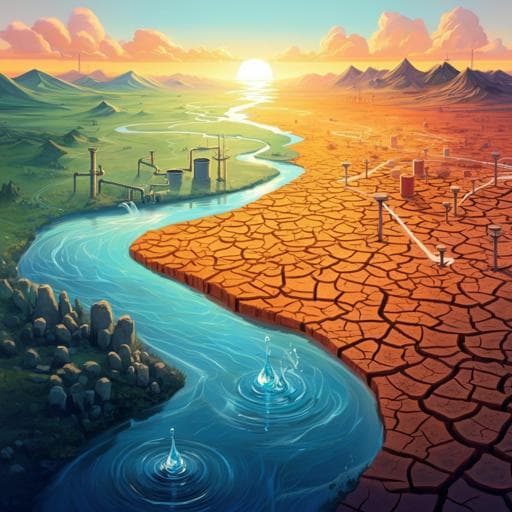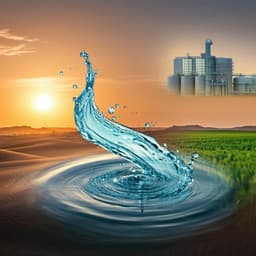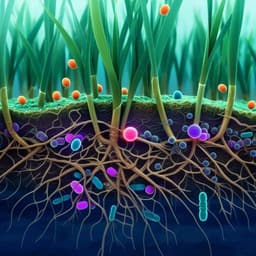
Environmental Studies and Forestry
Past and future trends of Egypt's water consumption and its sources
C. A. Nikiel and E. A. B. Eltahir
This comprehensive analysis by Catherine A. Nikiel and Elfatih A. B. Eltahir reveals a striking reality: Egypt's water demand has outpaced the Nile's supply since the late 1970s. The paper delves into historical trends driven by economic growth and anticipates future scenarios that challenge the conventional understanding of Egypt's water reliance. Dive into their findings to uncover the critical role of virtual water imports in shaping Egypt's water future.
~3 min • Beginner • English
Introduction
The study investigates when and how Egypt’s water demand exceeded the sustainable supply from the Nile and quantifies the roles of population and economic growth in driving that demand. Against a backdrop of rapid demographic expansion (about 2.1% annually from 1989 to 2018) and sustained economic growth (GDP per capita about 2.3% annually over the same period), Egypt’s diets and municipal/industrial uses have shifted, increasing pressure on scarce water resources while Nile inflows have remained relatively steady. The authors aim to reconstruct historical water use at high resolution, identify the drivers behind the observed trends, and develop an empirical demand model to project future water needs, with a central question of whether Egypt will continue to be sustained primarily by the Nile or increasingly by virtual water imports.
Literature Review
Previous work on Egypt’s water resources has often provided time-snapshot assessments of water use, reuse, and virtual water trade, including governmental reports and regional studies of the Middle East and North Africa. The concept of virtual water, introduced by Allan in the 1990s, has been applied to explain how water-scarce countries meet demand via imports. Other studies have quantified virtual water flows and outlined national water policies and reuse practices. However, gaps remain in year-by-year, crop-level reconstructions linking detailed agricultural water use to socioeconomic drivers and in empirically grounded projections of future demand that integrate population and GDP per capita growth. This study addresses these gaps by constructing a multi-decade, bottom-up record and developing demand relationships to project future needs.
Methodology
The authors perform a bottom-up, crop-level reconstruction of Egypt’s water use and virtual water trade over six decades. Agricultural production, area, yield, and trade data are sourced primarily from FAOSTAT (1961–2017, with missing values extrapolated using nearest available years and documented fill-ins). Municipal and industrial withdrawals and reuse are taken from FAO AQUASTAT and literature. Nile inflow is based on Dongola streamflow, adjusted for Lake Nasser evaporation and other surface evaporation, plus rainfall and primary groundwater abstraction. Storage changes are considered in schematic flux comparisons but not in the availability estimate of Fig. 3b. Crop water consumption uses Egypt-specific blue water evapotranspiration requirements (1996–2005 averages) from Mekonnen and Hoekstra and related sources; for commodities not grown domestically (e.g., tea), blue water numbers reflecting import sources are used. Water requirements are expressed in m³ per tonne, derived as the average of constant m³/ha and constant m³/tonne formulations to reflect yield and management changes. All agricultural water-use estimates are scaled by irrigation application efficiency, which is computed from irrigation technology shares and their efficiencies, increasing from roughly 61% in the 1960s to 65–66% by the mid-2010s. Reuse components include direct reuse of agricultural drainage, pumping of local groundwater recharge, and treated wastewater reuse; reuse series are compiled from literature and interpolated across sparse years. Virtual water imports are computed identically to in-country use by applying Egypt-equivalent blue water requirements (scaled by irrigation efficiency) to net imports (imports minus exports) of primary crops, key secondary commodities (e.g., sugar, molasses, cotton lint, edible oils and cakes), and animal products (meat, milk, eggs, cheese, butter), avoiding double counting by treating feed/meat consistently. An empirical demand model relates per capita demand for individual commodities to GDP per capita via linear regressions calibrated for 1975–2014; crops heavily policy-driven (berseem, seed cotton, sugarcane) are modeled using time-based relationships and held constant per capita in projections. Future projections (through 2035) assume that additional demand beyond 2017 levels is satisfied externally via imports because Egypt is at its in-country production limit, with municipal per capita use held constant (about 112 m³/capita/year). Industrial use and reuse are held at 2017 levels due to policy sensitivity. Population growth scenarios of 0.1–2.5% and GDP per capita growth of 0.1–4.5% are explored; a nominal scenario uses 1.7% population growth (UN medium variant) and 2.3% GDP per capita growth (1988–2017 average). Hindcasts of total water demand combine agricultural, municipal, and industrial components with reuse and are compared to the sum of in-country Nile use and virtual water imports. Uncertainty is acknowledged due to sparse official data, assumptions in irrigation efficiency, reuse estimation, and extrapolated trade/production series.
Key Findings
- Egypt’s total water demand outstripped available Nile supply in the late 1970s. The system transitioned from a surplus of about 20 km³/year in the 1960s to a deficit of about 40 km³/year by the late 2010s, covered by virtual water imports and expanded reuse.
- Average direct consumption of Nile water in Egypt (including agricultural, municipal, and industrial, and accounting for reuse and application losses) is estimated at roughly 61.5 km³/year over 1988–2017. Adding environmental flows to the Mediterranean of about 2–4 km³/year implies utilization exceeding the 55.5 km³/year allocation by approximately 8.0–10.0 km³/year, partly from Sudan’s unconsumed share (about 1.8–5.5 km³/year) and partly from increases in Nile flow (~5–6 km³/year).
- Virtual water imports rose substantially, reaching about 40 km³/year in the late 2010s. Cereal import dependency increased from 34% to 42% between 1999–2001 and 2011–2013.
- Irrigation application efficiency improved modestly from about 61% in the 1960s to around 65–66% by the mid-2010s, enhancing water productivity but insufficient to offset demand growth.
- Reuse expanded markedly: average reuse rose from about 2.9 km³/year in 1988–1995 to about 17.1 km³/year in 2010–2017, including treated wastewater (about 2.6 km³/year in 2010–2017), local groundwater use (~6.4 km³/year), and direct use of surface drainage (~8.1 km³/year), though with losses.
- Agricultural intensification increased harvested area and yields (notably cereals, fruits, and vegetables), but total agricultural application rose (e.g., from ~49.7 km³ to ~66.6 km³, with crop ET rising from ~30.4 km³ to ~43.3 km³ comparing 1988–1995 to 2010–2017), with field-scale losses decreasing over time.
- Projections indicate that under population and GDP per capita growth rates close to recent historical values (nominal scenario: 1.7% population growth and 2.3% GDP per capita growth), Egypt’s virtual water imports will reach about 61.5 km³/year during the 2020s, implying imports of virtual water will match or exceed average historical Nile withdrawals.
- By 2030, most population-economic growth scenarios require significant additional virtual water compared to 2017 levels; the annual increase in virtual water demand accelerates due to compounding growth.
- Lake Nasser evaporation increased with surface area changes (10–13 km³/year in 2010–2017 vs about 9–10 km³/year in 1988–1995), affecting the system balance.
- Despite relatively stable long-term Nile flood heights and mean flows, modern records show slight decreases at downstream gauges due to upstream withdrawals and regulation.
Discussion
The findings demonstrate that Egypt crossed the threshold of full utilization of its internal renewable water resources in the late 1970s and has since relied increasingly on virtual water imports to meet growing demand driven by population and income growth. The empirical model links rising GDP per capita with higher per capita consumption of water-intensive goods (notably animal products), explaining the accelerating demand. While infrastructure (High Aswan Dam), agricultural intensification, modest improvements in irrigation efficiency, and expanded reuse have buffered rising demand, these measures alone cannot close the gap. The analysis shows Egypt approaching a point where virtual water imports will equal or surpass Nile withdrawals during the 2020s, reframing Egypt’s identity from being sustained primarily by the Nile to a new paradigm of dependence on basin and global interconnections. Policy implications include adopting robust water pricing to reflect scarcity, optimizing trade portfolios (exporting high-value, high water-use efficiency produce; importing low-value, water-inefficient staples and meat), and prioritizing inter-basin and international cooperation. Reducing population growth through healthcare and education remains crucial to mitigate per capita scarcity. External stressors such as the GERD filling/operation and climate change (greater flow variability, sea level rise and salinization in the Delta, higher evaporation, and shifts in crop suitability) heighten the need for adaptive management, additional storage, and regional coordination.
Conclusion
This work reconstructs six decades of Egypt’s water demand at crop-level resolution, quantifies how and when demand exceeded the Nile’s carrying capacity, and develops an empirical demand model linking water demand to population and economic growth to project future needs. The central conclusion is that Egypt will increasingly depend on virtual water: under nominal growth, imports will reach approximately 61.5 km³/year during the 2020s, rivaling average Nile withdrawals. The study highlights the importance of enhancing irrigation efficiency, scaling reuse, implementing economic instruments like water pricing, and strategically managing agricultural trade. It also underscores the necessity of regional cooperation in the Nile Basin and globally. Future research should quantitatively assess impacts of GERD operations, incorporate climate change scenarios into demand-supply dynamics, improve data on reuse and groundwater interactions, evaluate storage and conveyance options under increased variability, and analyze policy levers affecting industrial water use and demand-side conservation.
Limitations
- GERD impacts are acknowledged but not quantitatively included.
- Climate change effects on flows, variability, evaporation, Delta salinization, and crop productivity are discussed qualitatively but not modeled.
- Several flux components are uncertain; schematic water balances integrate independent sources and may not close exactly.
- Reuse estimates are compiled from sparse literature and interpolations; future projections hold reuse and industrial use constant at 2017 levels, which may not reflect policy-driven changes.
- Agricultural water-use relies on blue water ET requirements averaged for 1996–2005 and scaled via irrigation efficiency; assumptions include that crops receive their ET requirement and that per-tonne water requirements for secondary commodities are constant over time.
- Berseem ET is taken from a study in northern India due to lack of Egypt-specific data and scaled accordingly.
- FAO trade/production gaps are filled or extrapolated for consistency, introducing uncertainty.
- The demand model assumes linear relationships with GDP per capita and imposes no upper bounds; policy-driven commodities are handled via time trends.
- The main projection assumption is that all additional post-2017 demand is met by imports, reflecting a binding in-country production limit, which may be altered by future policy or technology changes.
Related Publications
Explore these studies to deepen your understanding of the subject.







